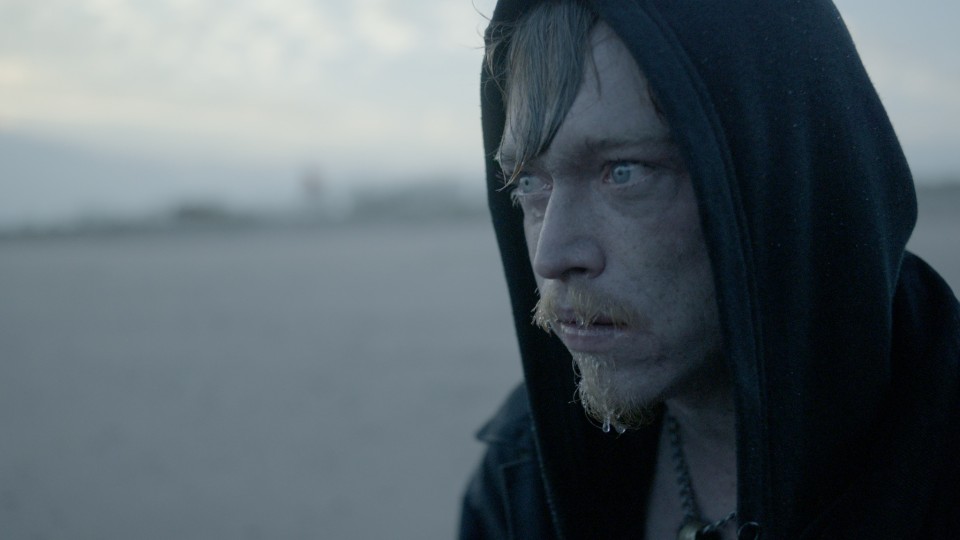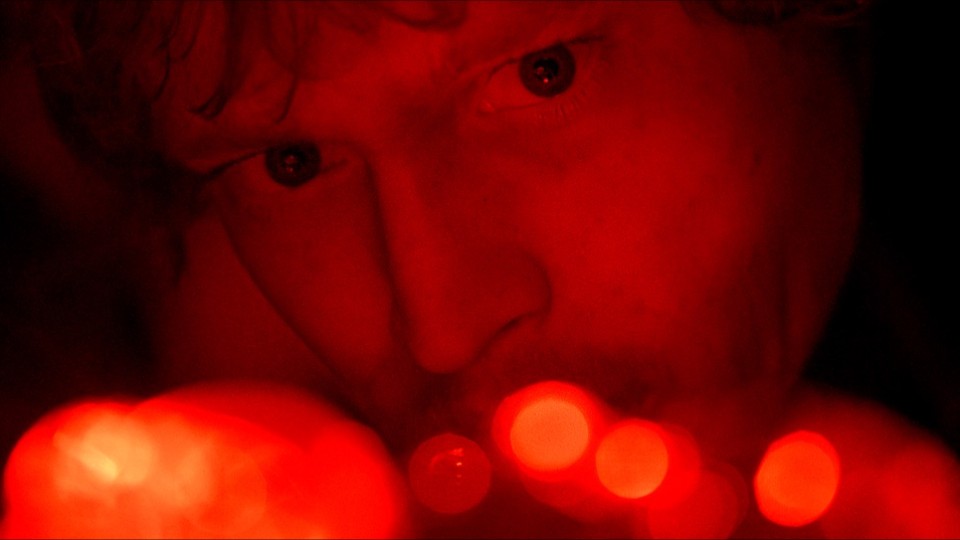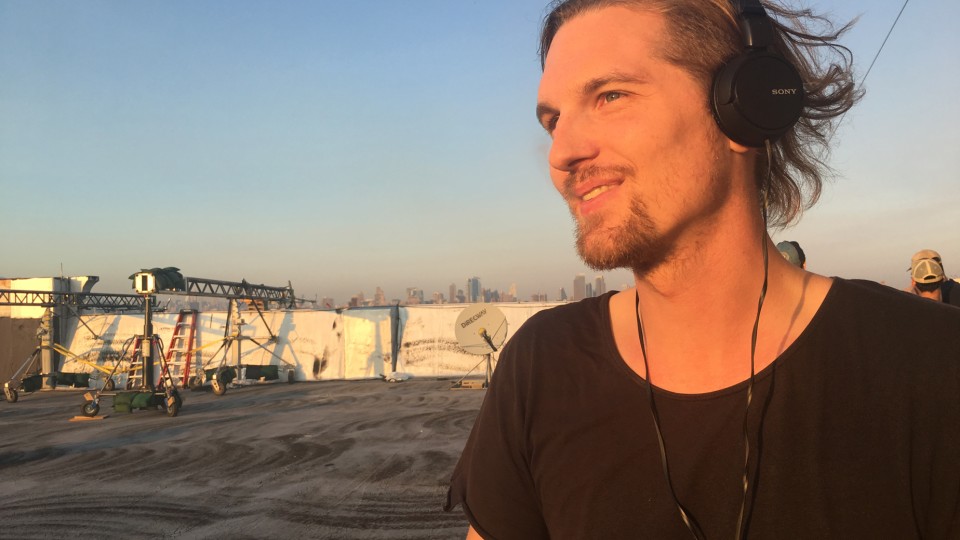In one of the first scenes we witness Norman, the protagonist of To the Night and evidently an established artist, presenting an installation of transparent baby bodies made of ice, illuminated in red.
What do these sculptures, which are exhibited in darkness, represent to the audience in terms of an introduction to Norman's
world?
PETER BRUNNER: The exhibition, as an introduction, is essentially a framework in which Norman's family – his little son Caleb and his
partner Penelope – occupy a central position. Without this family, and the stabilising power it exerts over Norman, there
would not be any exhibition. The melting ice babies, linked with breathing tubes and perfusors, can intensify themes in this
film from various perspectives and modes of audience reading, while they are at the same time physical results of Norman's
inner perceptions. For me this is very strongly about the subjective experience of time, and the desire to deal with, depict,
experience and grasp hold of time. I also find the exhibition interesting as a stage for an encounter where somebody like
Norman is accepted. Few visitors are interested in how a work comes about, the creative process and the condition of the person
behind it. But that was one of the initial considerations for this film.
Loss and grief are recurrent themes in your works, and it seems that you approach them with a sort of balancing act between
the internal and external realities of your characters. What is it that brings you back repeatedly to these subjects?
PETER BRUNNER: One reason I love film is that the medium makes it possible to penetrate extremely deeply into the conditions and transitions
of internal and external reality. This opportunity is otherwise only present, in a stronger but less specifically collective
manner, with music, drugs, hypnosis or certain forms of meditation. Each person carries inside an internal tempo. In To the Night we gaze from an internal perspective at the world of a Cobain-type character who has to take great care not to burn himself
in the fire with which he sets himself alight. I would speak less of loss and grief and more of longing. And the fear inherent
in that longing, which in Norman's case leads to addiction. It's a symbol. We find ourselves today in a turbo-capitalist society.
If it's possible to counter the greed for growth at all, it must be by means of longing for an opportunity to live in a different
way with oneself and the person one loves. Loss and grief may be a key aspect for you, because feeling is in the foreground
in this film – an extreme, excessive and ecstatic exploration and experiencing of feeling.
In To the Night the visual arts appear to be an appropriate method of dealing with trauma. Is it your intention to raise awareness of how
narrow the borderline can be between creativity and destructivity in the world of an artist?
PETER BRUNNER: It's very difficult to describe how somebody can have two contradictory standpoints at the same moment. My point is not about
an "artist" but about people and their creative potential to find survival strategies at times of need. Here the visual arts
are a framework in the search for trust and acceptance. Norman has to believe in a home, and to let trust and acceptance affect
him as a symbolic image, in order to be certain that there is another reality for him and his family. I'm less concerned with
the narrow borderline and more with the stamina and vehemence of someone who is condemned to suffer, someone we accompany
as he works his way back along the taut threads extending through his manic existence until he reaches a central point of
departure. Norman communicates with what he creates. He channels his fears. As a result his artistic expression is necessarily
part of his search for healing.
Norman, who lost his parents as a child, attempts to find a point of stability in a family of his own. What does his own fatherhood
do to him?
PETER BRUNNER: Questions occur to me in response to that: "How does a person live if he only has ideas but no security in his perception
of love?", "What is too much, what is too little, and can it ever be enough?" Becoming a parent is a devastating but boundlessly
beautiful new beginning, as far as I can judge. With Norman, fatherhood triggers unconscious survival mechanisms which confront
him with his past. This prompts him to do everything he can to cordon off his son from himself and his fears, to make another
destiny possible for the boy, and he is confronted with the question: "How is it possible to break out of an inner vicious
circle without destroying the people and the relationships you love?"
What role in Norman's life is played by his friend Andi, who you have cast with one of your regular actors, Christos Haas?
PETER BRUNNER: Working on my debut feature film My Blind Heart, where Christos Haas played a major role, was the foundation for the relationship between Norman and Andi. I am familiar
with a lot of the lines that Andi delivers in the film, and his overall mode of behaviour, from Christos, and after considerable
discussion we adopted them in the script for his character. The friendship between Norman and Andi, who is virtually blind,
becomes a foundation stone: he's the blind man who lets Norman see, and they provide each other with mutual assistance. Norman's
friendship with Andi, who models for him for his light installations – which are interpretations in sculpture of Andi's
body and his senses – is comparable to the love-hate relationship between Werner Herzog and Klaus Kinski; it's just that
here the energies are distributed differently. In Andi, Norman finds a counterpoint to himself. A person he admires for his
courage and fearlessness. When Norman looks at Andi, for him it's like gazing into a mirror, from an internal deficit to an
external one, and back again. Without many words being used, a lightness is possible between two people here, people who don't
judge each other and don't spare each other.
In Caleb Landy Jones, who plays the leading role, you found an actor whose career is very much on the rise at the moment.
What was that about him that you found so convincing? How did he come to inhabit the role of Norman?
PETER BRUNNER: In Caleb Landy Jones and Eléonore Hendricks in particular we found actors who approach these characters and their attitudes
with the same appetite and at the same time. In the script of To the Night Norman and Penelope’s child had been called Caleb for many years – because I saw Caleb Landy Jones in a film and
did some research on him. When I'd seen every possible film he had done it was clear to me that I wanted to work with that
person in this film. Caleb Landy Jones is able to make the range of emotions and tensions tangible that I look for in my material.
So it wasn't at all that I saw something particular within him. It was simply there. Since he is also a musician we quickly
found means of establishing universal contact, despite the German-English language barrier. Very often it felt as though we
were working together on an album or a song. So far I have encountered very few people, apart from Christos, Jana and my mother,
who are so brave and open in front of the camera. We only spent about two months preparing for shooting. One month with all
the other actors. During that time we started a punk band. Caleb recorded all the rehearsals, and later he put together songs
from some of the sound drafts. What can you possibly say about somebody who writes four albums a year in addition to his film
work? I have light years of respect for Caleb's ability to feel himself into such contradictory characters and then to let
themselves go again.
To the Night is your first English-language film, and it was shot in New York. Why was it important to you that the film shouldn't be
set in Vienna, for example? What was your experience of implementing the project with partners there, in terms of production
practicalities? What basic fascination does New York have for you, as a location?
PETER BRUNNER: At first, just under eight years ago, we did intend to make the film in Vienna. To the Night has a long and difficult history of financing. The story of To the Night is universal, and it could also be set in Durban, Paris or London. I found New York the ideal location, on the one hand because
the contradiction between internal experience and the hostility of the external reality is very visible, but also because
of the opportunity of working with Caleb, Eléonore and Abbey. As a fan of American independent cinema of the 1970s, of Velvet
Underground and of actors who trained in the Actors Studio, the city fascinates me. You get the feeling that a whole range
of ideas are possible there, although maybe that's simply because there are just more people around, so the chances are higher
that you will find the right partner you can implement these ideas with.
Interview: Karin Schiefer
June 2018





